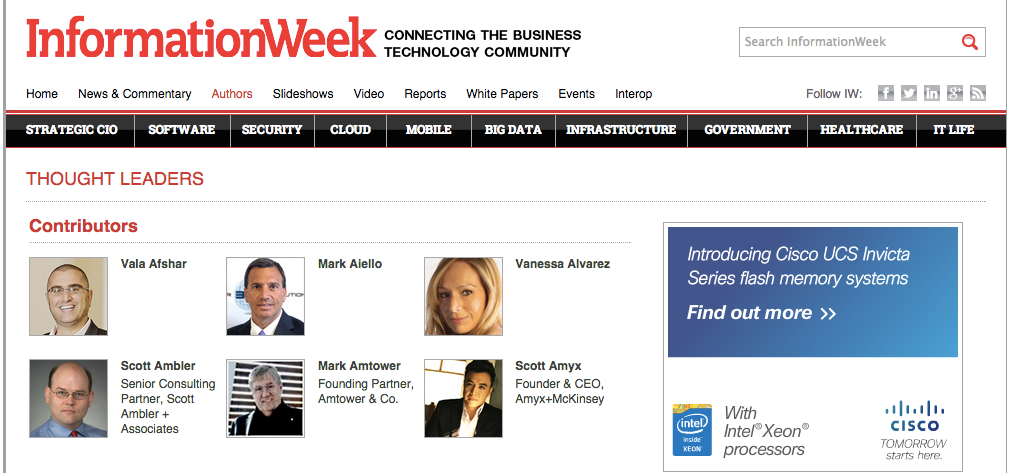The U.S. risks being left behind as other countries invest in ubiquitous computing. Here’s a seven-point framework to bolster the U.S.’s support of IoT technologies.
For the general public, the term Internet of Things (IoT), if they’ve even heard of it, is obscure technical jargon that has no impact on their personal lives. So why should the average voter care? Because the IoT has the potential to eclipse the largest and longest economic expansionary periods in human history. It could do more for the labor market, real GDP, and economic growth than any monetary policy by the Fed. Yet what is the U.S. government doing about it?
On the industry standards side, there is already momentum. The Industrial Internet Consortium is creating interoperability and security standards for machines to share information and to move data seamlessly. The SmartAmerica Challenge, a project spearheaded by Presidential Innovation Fellows and the National Institute of Standards and Technology, is facilitating demos and discussions on how machine-to-machine (M2M) interaction can bring tangible benefits to society. The group’s current focus is on healthcare and security applications. GovLoop organized a conference, attended by government officials from the Defense Advanced Research Projects Agency, Transportation Department, and Veterans Health Administration, as well as business leaders, to discuss the potential applications of IoT in the public sector. The Federal Trade Commission (FTC) held a workshop last November to explore consumer privacy and security issues posed by IoT. The FTC has made it a priority to bring enforcement cases against deceptive business practices in the Internet of Things.
But is this enough?
To answer that question, we first need to benchmark against the other economies that, combined with the U.S., represent 84% of the IoT market.
China
The Chinese government is expected to invest more than $600 billion in IoT through 2020. According to a GSMA report “How China is Set for Global M2M Leadership,” China is the global leader in the adoption of M2M technology with more than 50 million connections in 2013. National policy support grew the M2M connectivity market, with the cooperation of China’s largest mobile operators — China Mobile, China Unicom, and China Telecom — to nurture a vibrant ecosystem across sectors.
China’s Ministry of Industry and Information Technology released its 12th Five-Year Development Plan in 2012, with the goal of scaling the IoT market to RMB 1,000 billion ($163 billion) by 2020. The midterm information and communications technology (ICT) development report of the 18th Central Committee of the CPC Congress significantly expanded the focus on new sectors such as cloud computing and the IoT. Specifically, the Circular 181 and Circular 42 provide preferential tax policies for the software and integrated circuits industries, including interpretation to include IoT manufacturers. The government and private sectors have been tasked with setting communication and security standards, demonstrating practical applications, nurturing new businesses, and planning the regional distribution of the IoT industry. In addition, the IoT Special Fund promotes IoT R&D, applications and services. Grants are offered to self-funded projects, and loan subsidies support enterprises with bank-loan funding.
Europe
As part of UK Prime Minister David Cameron’s announcement to drive 5G research in partnership with Germany, Cameron unveiled a new set of measures that include a £45 million ($74 million) budget for IoT projects, tripling what was already available, and a £1 million ($1.6 million) European grant fund for companies investing in IoT. Additionally, Parliament members Chi Onwurah and Michael Dugher have launched Labour’s “Digital Britain 2015″ to review how digital technology can improve the efficiency of public services, to develop a framework for powering digital government, and to put citizens in control of their own data.
A UK government-backed consortium of companies has launched a new open specification called HyperCat, with £6.4 million ($10.5 million) in funding from the UK Technology Strategy Board, to support M2M interoperability by leveraging an online metadata catalog for universal communication between IoT devices.
Germany’s INDUSTRIE 4.0 strategic initiative in its High-Tech Strategy 2020 Action Plan establishes the framework to enable the country to take a leadership role in the manufacturing engineering sector, including in IoT.
Korea
The South Korean government in May 2014 came up with a master plan for developing IoT services and products through setting up an open IoT ecosystem consisting of service, platform, network, device, and IT security sectors. South Korea aims to increase its domestic market for the Internet of Things from KRW 2.3 trillion in 2013 to KRW 30 trillion ($28.9 billion) by 2020.
The South Korean government has set aside KRW 50 billion ($49 million) over the next five years to grow the IoT market. The country’s Ministry of Science, ICT, and Future Planning and Ministry of Trade, Industry, and Energy will invest KRW 37 billion from 2015 in the development of core IoT technologies. Another KRW 12.3 billion will come from Korea’s private sector, giving an overall investment of KRW 50 billion. The government also has plans to increase the technical labor pool in IoT technologies.
What about the U.S.?
It’s feasible that the U.S. government has an industry blueprint and policy framework for promoting IoT, or perhaps it’s underway. If such a plan exists, the government needs to promote it.
The Smart Cities USA project, a collaboration between Intel and the City of San Jose, Calif., is trying to demonstrate the benefits of IoT to support San Jose’s Green Vision initiative, with the hope of spurring other cities across America to adopt a similar IoT-friendly policy.
Anecdotally, in a GovLoop survey of 800 public sector employees, 49% indicated that they have never heard of the term “Internet of Things,” 16% had heard of the term but were not sure about the definition, and 35% had heard of the term and had some understanding of IoT. One survey respondent questioned, “what does this even have to do with any of the service-provided departments of government?” This could be due to survey bias in terms of the types of agencies and management levels surveyed, but it does raise a question about the government’s awareness and readiness to foster a vibrant IoT market.
Brett Goldstein, Chief Data and Information Officer for the City of Chicago, spoke out through the New York Times to rally public officials to stand behind the IoT. Abroad, BT CIO Clive Selley challenged his UK government to “articulate the business case enough to espouse and publicize the benefits of the Internet of Things.”
Case Study: U.S. government’s role in the solar photovoltaics industry
Government policies play a pivotal role in nurturing a nascent market. Uncertain market conditions and risks, such as demand, standards, and regulations, and the significant investment costs associated with R&D and infrastructure upgrades keep enterprises and public agencies on the sideline. The solar photovoltaics (PV) industry, as an example, would not have gotten off the ground without government policies to support consumption of solar energy and the production of solar PV products.
In Q2, the U.S. solar PV installations topped the gigawatt mark for the third consecutive quarter to 1,133 megawatts (MW) to bring the cumulative installed solar capacity to 15,900 MW. There are now more than half-a-million homes and businesses nationwide with a solar installation. Through the first half of the year, 53% of all new electric capacity installed has come from solar.
The city of Lancaster, Calif., has gone one step further to require every new housing development to generate at least an average of 1 kilowatt from solar energy. The new requirement will be updated in Lancaster’s Residential Zones code.
Government subsidies do have downsides
SolarCity, a publicly traded solar power provider, has never recorded a profit. It was $166 million in the red after losing $55 million in 2013, yet its stock price, $63 at the time of this writing, is up by 688% since its IPO in late 2012. The pricing model for SolarCity’s stock implicitly reflects advantages afforded by the government. Buried deep in its third-quarter 2013 report, SolarCity states, “If, for any reason, we are unable to finance solar energy systems through tax-advantaged structures … we may no longer be able to provide solar energy systems to new customers on an economically viable basis. This would have a material adverse effect on our business, financial condition, and results of operations.”
Overseas, government protectionism has resulted in powerful oligopolies (or in some extreme cases, monopolies) across sectors that disproportionately enrich a select few companies and their founders with outrageous valuations and exits, all at the expense of and risk to citizens.
To be fair, the solar PV market fundamentals are not comparable to the IoT industry. For Industrial Things, the issue is not whether it’s a financially viable, self-sustaining market; rather it’s about the pace of growth vis-a-vis global competitors. It’s a race toward global market share that has the potential to power the growth engine of our domestic economy.
Framework for government IoT policy
The role of the government, in this case, is to alleviate the risk barriers of a nascent market. Regulatory uncertainty can be the death of burgeoning industry. What follows is a recommended framework for the U.S. government to support the IoT market:
1. Policy: Create a plan, then promote it
The U.S. government must develop, publish, and promulgate a national IoT plan. As noted earlier, if the plan is not known by the public, if might as well not exist. The government should define a national strategy, a roadmap, and the supporting policy framework and programs to advance the growth of the Internet of Things industry.
2. Risk mitigation: Spearhead technology, privacy, and security standards & enforcement
This is one area that we are seeing positive progress with joint public- and private-sector collaboration. Particularly on the privacy and security standards, there is already a significant body of work established; it needs to be expanded to account for wearables and M2M technologies. Until the government steps in to set clear guidelines and the corresponding enforcement, supported by industry consortiums, the general public will distrust wearables and IoT.
3. Technologies: Establish R&D funds
The government can reinforce R&D investments to cultivate IoT growth, to concentrate on developing core technologies, and to create new markets. In addition, the government needs to maximize the investment effects by developing methods to strengthen the system that evaluates the relative value of R&D results and to establish management responsibility systems.
4. Talent: Support educational development
The Internet of Things will accelerate the knowledge economy. Its economic promise will warrant government education funding to boost IoT talent. This will help address the need for specialized knowledge workers in areas such as embedded systems, wireless networks, cognitive science, big data, robotics, wearables, and security.
Funds will support education, research, and collaborative public-private sector initiatives to nurture and attract top students and academics and to connect them with leading IoT firms and startups.
5. Demand creation: Incorporate IoT into LEED and construction permits and standards
Revisions to the building code and Leadership in Energy and Environmental Design (LEED) standards to require the use of M2M sensor technologies in construction and renovation can single-handedly secure the national demand part of the equation. Those standards can affect energy, transportation, communications, mining, oil and gas, and government civil engineering projects to create a massive demand economy. We are already seeing some movement in this direction, but much more is needed at the national policy level, which can then be implemented by the states.
The California Energy Commission recently updated its Title 24 Energy Efficiency Standards to require photosensors, occupancy sensors, and multi-level lighting controls, both indoors and out, making adaptive lighting the new standard in California. The California Energy Commission projects the non-residential standards alone will save the state 372 GWh every year.
The California Public Utilities Commission’s Long Term Energy Efficiency Strategic Plan has also called for a 60% to 80% statewide reduction in electrical lighting consumption by 2020. This is on top of the goal to make all new residential construction net-zero by 2020, and commercial construction net-zero by 2030. Since lighting currently accounts for nearly 30% of California’s electricity use, the extensive use of lighting controls is absolutely essential to meeting these net-zero goals.
This doesn’t begin to account for efficiencies and savings of water and gas nor the monitoring of physical assets, such as bridges, highways, and skyscrapers for post-natural disasters, such as an earthquake, to evaluate structural impact and damage assessment through IoT sensors and systems.
Additionally, LEED standards, created by the U.S. Green Building Council, can be updated to incorporate IoT technologies into new constructions and major renovations to further its green building goals.
6. Demand creation: Spur public-sector projects
As part of its fiscal policy toolbox, the U.S. government should conduct cost-benefit analyses of pursuing public-sector IoT projects, so long as the political winds allow it.
Public-sector IoT projects work elsewhere in the world. South Korea implemented smart city initiatives to develop new residential cities near Seoul’s outskirts. Under the comprehensive plan to build ubiquitous cities, the Ministry of Land, Infrastructure, and Transportation is striving to complete 73 city projects.
Similarly, the Chinese central government has selected 202 cities to pilot smart city projects to collect and analyze transportation, electricity, public safety and environmental data.
7. Financing: Loans, tax privileges, and subsidies
The U.S. government can also consider special funds to optimize financing for the Internet of Things, such as infrastructure funds, loans, tax privileges, and other subsidies, while weighing programmatically the economic and social benefits against the investment costs. The key is to ensure that the parameters of government financial support are constrained by the oversight of an independent audit committee to evaluate the merits and management of programs. These tools can be dangerous, fraught with perverse incentives and unintended policy consequences, so they should be used with caution.
Conclusion
The Internet of Things faces significant obstacles that impede mass adoption. The U.S. government can exercise leadership by partnering with the private sector to create a structured government policy to systematically nurture the next major growth engine for the American economy.

Originally published on InformationWeek on October 9, 2014. Author Scott Amyx.


















